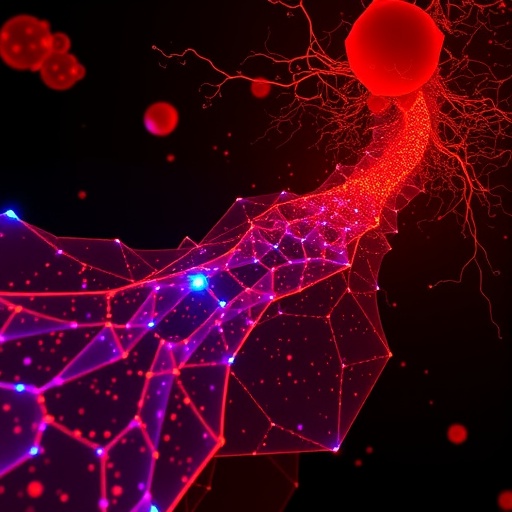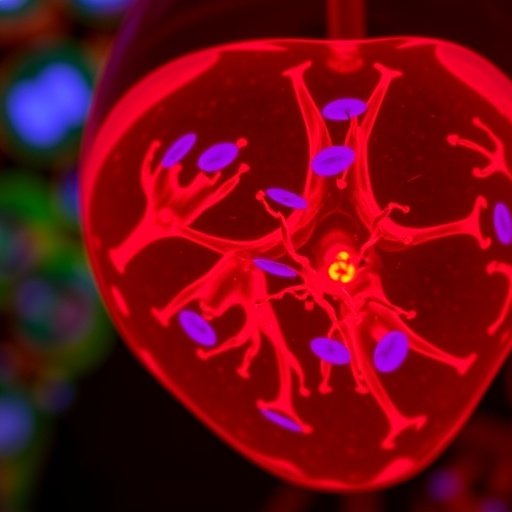In a groundbreaking study published recently in Cell Death Discovery, a team of researchers led by Miao, N., Kang, Z., and Wang, Z. have unveiled a critical mechanism by which mitochondrial reactive oxygen species (ROS) facilitate cancer metastasis and induce immunosuppression within the tumor microenvironment. This discovery not only deepens our understanding of tumor biology but also opens new avenues for targeted therapies aimed at mitigating cancer progression and improving patient outcomes.
At the core of this study lies the often-overlooked role of mitochondria, those cellular powerhouses renowned primarily for energy production. While mitochondria are well-known sources of reactive oxygen species, molecules typically associated with cellular damage, their involvement in cancer biology has gained increasing attention. This research highlights how mitochondrial ROS act as signaling molecules to activate gasdermin D, a pivotal executor of pyroptosis, ultimately driving metastatic behavior and shaping an immunosuppressive niche that favors tumor growth.
Mitochondrial ROS have traditionally been viewed merely as toxic byproducts of oxidative phosphorylation. However, emerging evidence from this study challenges that paradigm by revealing their nuanced role as modulators of cellular communication within the tumor milieu. The researchers demonstrate that elevated mitochondrial ROS levels correlate strongly with increased expression and activation of gasdermin D, thus linking metabolic dysfunction directly to immune evasion and metastatic potential in cancer cells.
Gasdermin D, a member of the gasdermin family known for its capacity to form pores in cellular membranes, has been previously implicated in inflammatory cell death pathways. The current research delineates a novel function whereby mitochondrial ROS induce conformational changes in gasdermin D, triggering pyroptotic processes that paradoxically benefit tumor cells by remodeling the microenvironment to suppress anti-tumor immunity. This finding challenges previous notions that pyroptosis universally serves protective functions and suggests a context-dependent role in cancer progression.
The interplay between mitochondrial ROS and gasdermin D activation was studied across multiple cancer models, employing both in vitro assays and in vivo animal studies. The research team utilized cutting-edge imaging techniques and biochemical assays to quantify ROS levels, gasdermin D cleavage, and downstream immune cell responses. Their data show a clear causative link: mitochondrial ROS acts upstream to facilitate gasdermin D-mediated pyroptosis, which then triggers a cascade of immunosuppressive signals within the tumor microenvironment.
Crucially, the immunosuppressive state established by this pathway involves downregulation of cytotoxic T-cell activity and promotion of regulatory T-cell phenotypes, tipping the balance toward tumor tolerance. This immune modulation is further compounded by alterations in cytokine profiles and recruitment of myeloid-derived suppressor cells, creating a fortress-like environment that shields cancer cells from host immune attack. The study delineates the molecular mediators involved, highlighting potential therapeutic targets for disrupting this vicious cycle.
In light of these discoveries, the authors advocate for reevaluating therapeutic strategies that target mitochondrial function and ROS production in cancer. While antioxidants have been previously considered to impede tumor growth by neutralizing ROS, this research suggests a more refined approach, aiming to specifically inhibit the mitochondrial ROS-gasdermin D axis. Such targeted intervention could disrupt metastatic progression and relieve immunosuppression without impairing physiological ROS signaling critical for normal cellular functions.
Moreover, the relationship between mitochondrial ROS and gasdermin D was examined in the context of tumor heterogeneity. Not all cancer cells exhibit uniform ROS generation, and the researchers observed that subpopulations with heightened mitochondrial dysfunction were particularly adept at exploiting this pathway to evade immune surveillance. This nuanced understanding could inform personalized medicine approaches, tailoring treatments based on metabolic profiles of individual tumors.
The study also delves into the signaling networks bridging mitochondrial ROS production and gasdermin D activation. Data reveal involvement of upstream kinases and adaptor proteins that sense oxidative stress and transduce signals resulting in gasdermin D cleavage. Identification of these intermediates offers additional druggable targets, expanding the molecular toolbox for curbing metastatic dissemination and immunosuppression.
Beyond the molecular intricacies, the broader implications of this research touch upon the dynamic nature of the tumor microenvironment. By elucidating how metabolic reprogramming and redox imbalances orchestrate immune escape, the findings enrich our conceptual framework of tumor-host interactions. They highlight the mitochondrion not just as a metabolic organelle but as a sophisticated communicator in the tumor ecosystem, influencing immune cell fate and function.
Given the rising incidence of metastatic cancers worldwide, understanding mechanisms that underlie metastatic competence is critical. This study represents a significant milestone by linking mitochondrial oxidative stress to immune environment remodeling through gasdermin D. It challenges researchers and clinicians alike to rethink how metabolic pathways intersect with immune modulation in cancer, paving the way for novel therapies that simultaneously target metabolism and immune dysfunction.
Future research building on these findings may explore the temporal dynamics of mitochondrial ROS and gasdermin D activation during different cancer stages, as well as their interactions with stromal and immune cell populations. Additionally, the potential for mitochondrial ROS-targeted therapies to synergize with immune checkpoint inhibitors or adoptive cell therapies holds promise and warrants rigorous clinical investigation.
In conclusion, the work by Miao and colleagues provides a compelling narrative of how mitochondrial ROS, long regarded merely as damaging metabolic byproducts, serve as critical signaling molecules that activate gasdermin D, promoting both metastasis and immunosuppression in tumors. This dual role spotlights the complexity of tumor biology and the potential to exploit these pathways for therapeutic gain. As the scientific community continues to unravel the multifaceted functions of mitochondria in cancer, such insights will be invaluable for designing next-generation treatments aimed at improving survival and quality of life for cancer patients.
Subject of Research: The role of mitochondrial reactive oxygen species (ROS) in promoting cancer metastasis and tumor microenvironment immunosuppression mediated through gasdermin D.
Article Title: Mitochondrial reactive oxygen species promote cancer metastasis and tumor microenvironment immunosuppression through gasdermin D.
Article References:
Miao, N., Kang, Z., Wang, Z. et al. Mitochondrial reactive oxygen species promote cancer metastasis and tumor microenvironment immunosuppression through gasdermin D. Cell Death Discov. 11, 219 (2025). https://doi.org/10.1038/s41420-025-02516-7
Image Credits: AI Generated
DOI: https://doi.org/10.1038/s41420-025-02516-7
Tags: cancer metastasis mechanismscancer progression understandingcellular communication in tumorsgasdermin D activationMiao Kang Wang studymitochondrial reactive oxygen speciesmitochondrial roles in cancer biologyoxidative phosphorylation byproductspyroptosis and cancertargeted cancer therapiestumor growth dynamicstumor microenvironment immunosuppression





